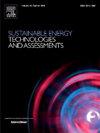Energy harvesting technologies on high-speed railway infrastructure: Review and comparative analysis of the potential and practicality
IF 7.1
2区 工程技术
Q1 ENERGY & FUELS
Sustainable Energy Technologies and Assessments
Pub Date : 2025-02-01
DOI:10.1016/j.seta.2025.104187
引用次数: 0
Abstract
A comprehensive quantitative analysis is provided of the potential applications of energy harvesting (EH) technologies tailored to high-speed railway infrastructure. The study compares the various energy sources within railway infrastructure and identifies suitable EH technologies. Feasible designs and scales of EH are assessed based on the installation location; the overall power availability and energy yield are compared for a notional high-speed railway. For resonant EH devices an assessment is also given of the optimal tuning frequency. Vibration-based EH, when applied to the track or bridge structures, can provide sufficient power for individual low-power sensors; however, its output is insufficient for higher-power applications or for data transmission unless energy storage devices are incorporated. Despite the elevated noise levels generated by high-speed trains, the energy available from this acoustic source is negligible and impractical for EH. Small vertical axis wind turbines installed close to the track and driven by passing trains show great potential, capable of harvesting several orders of magnitude more energy than vibration-based EH. Solar photovoltaic panels can generate significantly more energy than other methods, although their output is confined to daylight conditions and is contingent upon weather conditions.
求助全文
约1分钟内获得全文
求助全文
来源期刊

Sustainable Energy Technologies and Assessments
Energy-Renewable Energy, Sustainability and the Environment
CiteScore
12.70
自引率
12.50%
发文量
1091
期刊介绍:
Encouraging a transition to a sustainable energy future is imperative for our world. Technologies that enable this shift in various sectors like transportation, heating, and power systems are of utmost importance. Sustainable Energy Technologies and Assessments welcomes papers focusing on a range of aspects and levels of technological advancements in energy generation and utilization. The aim is to reduce the negative environmental impact associated with energy production and consumption, spanning from laboratory experiments to real-world applications in the commercial sector.
 求助内容:
求助内容: 应助结果提醒方式:
应助结果提醒方式:


